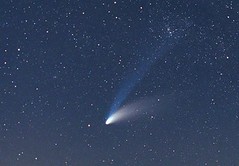Already I have received some feedback explaining the twin comet tails in more detail, or rather correcting the way I had written it in the Comet Facts article.

Driftwords explains:
One tail is neutral particles (dust) and the other consists of electrically charged gas (plasma). The charged particles (the "ion tail") are affected by the magnetic field of the sun, which is typically directed across the path of the comet, whereas the neutral particles simply show where the comet has been.
It's like a long steam train. The carriages behind the loco simply follow the track, whereas the smoke from the engine will be carried sideways by the wind as well.
No comments:
Post a Comment